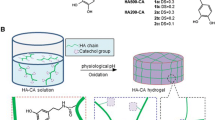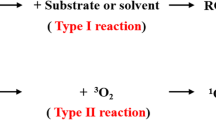Abstract
The functional conjugations with natural polyphenols could be a working strategy for accomplishing the degradation resistance of hyaluronic acids (HA). Herein, a series of HA conjugates with four different polyphenols with wide ranges in the degree of substitution were systematically prepared. The degradation rate could be retarded in a wide range without crosslinking: The conjugates having polyphenolic aglycone (catechin or quercetin) maintained their structures, as identified by viscosity, for up to 7 weeks in the presence of hyaluronidase. This retardation was outstanding compared to those reported from previous studies, and the physical mixtures of HA and polyphenols still showed significantly more retarded degradation than pristine HA. The degradation resistance could be controlled by varying the feed ratio of polyphenols. This conjugation method of polyphenols could open up new application areas of HA with the outstanding degradation resistance.

Similar content being viewed by others
References
G. Williamson, C. D. Kay, and A. Crozier, Compr. Rev. Food Sci. F., 17, 1054 (2018).
S. Srivastava, R. R. Somasagara, M. Hegde, M. Nishana, S. K. Tadi, M. Srivastava, B. Choudhary, and S. C. Raghavan, Sci. Rep., 6, 24049 (2016).
D. Carmona-Gutierrez, Zimmermann, K. Kainz, F. Pietrocola, G. Chen, S. Maglioni, A. Schiavi, J. Nah, S. Mertel, and C. B. Beuschel, Nat. Commun., 10, 651 (2019).
G. Regev-Shoshani, O. Shoseyov, I. Bilkis, and Z. Kerem, Biochem. J., 374, 157 (2003).
K. D. Winter, G. Dewitte, M. E. Dirks-Hofmeister, S. D. Laet, H. Pelantová, V. Křen, and T. Desmet, J. Agri. Food Chem., 63, 10131 (2015).
M. Shin and H. Lee, Chem. Mater., 29, 8211 (2017).
K. Halake, M. Birajdar, and J. Lee, J. Ind. Eng. Chem., 35, 1 (2016).
J. H. Waite and M. L. Tanzer, Science, 212, 1038 (2018).
W. Jiang and M. Hu, RSC Adv., 2, 7948 (2012).
N. Ihara, S. Schmitz, M. Kurisawa, J. E. Chung, H. Uyama, and S. Kobayashi, Biomacromolecules, 5, 1633 (2004).
C. E. Schanté, G. Zuber, C. Herlin, and T. F. Vandamme, Carbohydr. Polym., 85, 469 (2011).
F. Picotti, C. Chung, X. Jia, M. A. Randolph, and R. Langer, Carbohydr. Polym., 93, 273 (2013).
J. A. Burdick, C. Chung, X. Jia, M. A. Randolph, and R. Langer, Biomacromolecules, 6, 386 (2005).
K. Halake and J. Lee, J. Ind. Eng. Chem., 54, 44 (2017).
S. Ahn, K. Halake, and J. Lee, Int. J. Biol. Macromol., 101, 776 (2017).
J. H. Lee and G.H. Kim, J. Food Sci., 75, H212 (2010).
S. P. Zhong, D. Campoccia, P. J. Doherty, R. L. Williams, L. Benedetti, and D. F. Williams, Biomaterials, 15, 359 (1994).
F. Lee, J. E. Chung, K. Xu, and M. Kurisawa, ACS Macro Lett., 4, 957 (2015).
V. Simulescu, M. Kalina, J. Mondek, and M. Pekar, Carbohydr. Polym., 137, 664 (2016).
K. Gwon, E. Kim, and G. Tae, Acta Biomater., 49, 284 (2017).
A. Singh, M. Corvelli, S.A. Unterman, K. A. Wepasnick, P. McDonnell, and J. H. Elisseeff, Nat. Mater., 13, 988 (2014).
X. Yang, A. Singh, E. Choy, F. J. Hornicek, M. M. Amiji, and Z. Duan, Sci. Rep., 5, 8509 (2015).
J. Ge, R. Cai, L. Yang, L. Zhang, Y. Jiang, Y. Yang, C. Cui, S. Wan, X. Chu, and W. Tan, ACS Sustain. Chem. Eng., 6, 1655 (2018).
S. Mitragotri, P. A. Burke, and R. Langer, Nat. Rev. Drug Discov., 13, 655 (2014).
S. Khetan, M. Guvendiren, W. R. Legant, D. M. Cohen, C. S. Chen, and J. A. Burdick, Nat. Mater., 12, 458 (2013).
G. Palmieri, A. Rinaldi, L. Campagnolo, M. Tortora, M. F. Caso, M. Mattei, A. Notargiacomo, N. Rosato, M. Bottini, and F. Cavalieri, Part. Part. Syst. Charact., 34, 1600411 (2017).
K. L. Chao, L. Muthukumar, and O. Herzberg, Biochemistry, 46, 6911 (2007).
M. Aviv, M. Halperin-Sternfeld, I. Grigoriants, L. Buzhansky, I. Mironi-Harpaz, D. Seliktar, S. Einav, Z. Nevo, and L. Adler-Abramovich, ACS Appl. Mater. Interfaces, 10, 41883 (2018).
A. Papadopoulou and R.A. Frazier, Trends Food Sci. Technol., 15, 186 (2004).
A. M. L. Sousa, T. D. Li, S. Varghese, P. J. Halling, and K. H. Aaron Lau, ACS Appl. Mater. Interfaces, 10, 39353 (2018).
Author information
Authors and Affiliations
Corresponding author
Additional information
Publisher’s Note Springer Nature remains neutral with regard to jurisdictional claims in published maps and institutional affiliations.
Acknowledgment: This work was supported by a National Research Foundation grant from the Korean Ministry of Science, ICT, and Future Planning (Engineering Research Center 2014R1A5A1009799).
Electronic supplementary material
Rights and permissions
About this article
Cite this article
Halake, K., Lee, J. Outstanding Degradation Resistance of Hyaluronic Acid Achieved by Flavonoid Conjugations: Rheological Behavior. Macromol. Res. 28, 351–355 (2020). https://doi.org/10.1007/s13233-020-8068-2
Received:
Revised:
Accepted:
Published:
Issue Date:
DOI: https://doi.org/10.1007/s13233-020-8068-2




